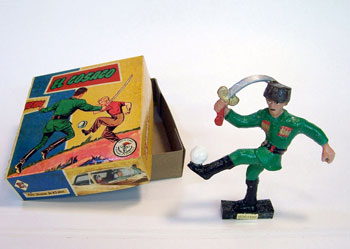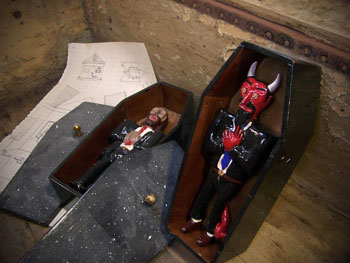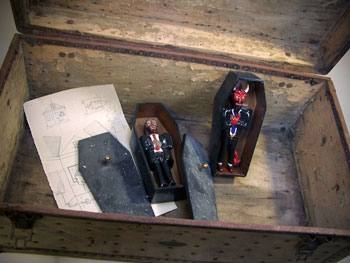Randy Regier
 |
 |
 |
 |
 |
Even though it looks damn spiffy, Randy Regier's show of playthings cannot be neatly pre-packaged for your viewing consumption. Multiple taxonomies may be used to classify this work. Where and how these things came into existence remains purposefully unexplained. This mystery creates a permissive environment for the judgments of the viewer (in the natural spirit of art and play). Those of you zealous dreamers with voracious appetites for the remarkable who want to dig deep will be floored by what will inhabit Whitney Art Works. Here are some highlights of what you’ll see. What you'll make of it all is another thing.
Silver planes the size of bread boxes, recovered from Portland trees, sport that unassuming red star that to many Americans recalls a very chilly time and place. From the forward gun chambers spill forth copies of the 1968 poem by Russian poet Yevgeny Yevtushenko, "Freedom to Kill." The poem is an indirect lamentation of the death of Robert Kennedy that spirals into an impassioned and frothing indictment of violence and corruption in the United States. These planes remind us that play can be complicated by the outside world. Those who make toys (nations, companies, parents, or artists) can have insidious agendas and those who play with toys are not always enacting natural or innocent scenarios.
That said you may choose to play however you would like, as an art viewer, a child, an aesthete, a cynic, a politician, a historian, or as a storyteller. Whether relics, toys, or objets d'art, the interpretation and appreciation for these items is open territory rife with possibility. And through it all, albeit slippery as all hell, there is a reality that bites at the heels of fiction. Throughout any place, hidden latent and spore-like are the histories and stories reflecting our surroundings and the values of our society.
Like William Golding writing Lord of the Flies, Reiger opens the door to real, potent societal metaphors in unassuming forms and asks that we believe. The cruelness of collective human consciousness deliriously exists within a proper English boyhood or in the story of a plaything.
Toys have a beguiling sensuality and they are marginally operational enough to spark a believable fiction. We require great literature to somehow succinctly gather from the messy threads of a story, a truth that a work of nonfiction would never dare relate, that describes human life or some aspect of it in a goose-bump rising kind of way. We ask the impossible of fiction, that it fully convinces us, rooted in some sort of probability while stretching the length and breadth of credibility. On Regier’s persuasive powers Greg Cook of the Boston Phoenix wrote,
"Portland artist Randy Regier's work is just beginning to be known, but he may be one of the best sculptors in the country. In the 2010 DeCordova Biennial at the DeCordova Sculpture Park + Museum, Regier has installed Honorable Mention: H. Maxwell Fisher and the Space Race, a "life-size" spacecraft, spacesuit, and related ephemera. Your senses tell you this wondrous, crackpot 1950s Buck Rogers dream machine is real. And you — particularly if you're a certain kind of boy — may want to believe it's real. But your mind insists that it's fake. The result of this contradiction is a pleasurable mental short circuit."
Read more at The Boston Phoneix
And at art & other important things
Also see some shots of the exhibition at flickr
Randy Regier is on view through June 26th
Whitney Art Works is open Wednesday - Saturday from 12- 6pm or by appointment
-Celeste Parke
© Whitney Art Works, All Rights Reserved. 45 York Street, Portland, Maine 04101 Voice: 207-780-0700
You are viewing the printer-friendly version of Randy Regier